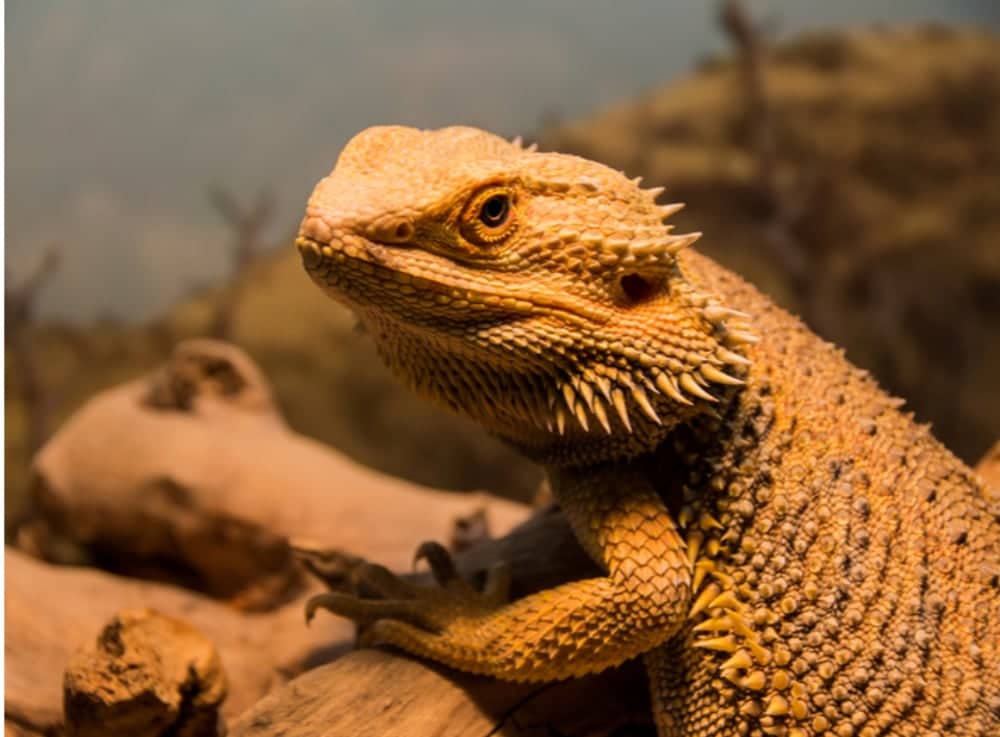Before you decide whether to bring the herp home, there are questions you have to ask the current owner.
The excitement you feel when bringing home a new herp is a feeling we are all familiar with. After careful research and planning, your new friend is ready to be acclimated to its new home. With the many considerations needed when acquiring a new herp, there are even more when it has had a previous owner. Its diet, habits, habitat, and temperament have been developed by someone else, and sometimes they don’t take care of the animal the way they should.
This article will walk you through everything you need to consider when buying or adopting a herp from a previous owner. Deciding to bring a pre-owned herp into your family is a big decision, one that will affect you and the herp, so it’s important to consider whether adopting a herp with a previous owner is right for you.
What To Think About Beforehand
You’re browsing a website, say your favorite breeder’s or even Craigslist, and you see a listing for rehoming a herp that you’ve been wanting. Before replying to the listing, do research on how to care for the species, if you haven’t already. One of the best sources of accurate herp information is on REPTILES magazine’s website, but there are other places to look as well, such as breeder’s websites and species-dedicated forums. Some of the most important questions to answer are: What types of illnesses are they most prone to? How do you tell if they are healthy?
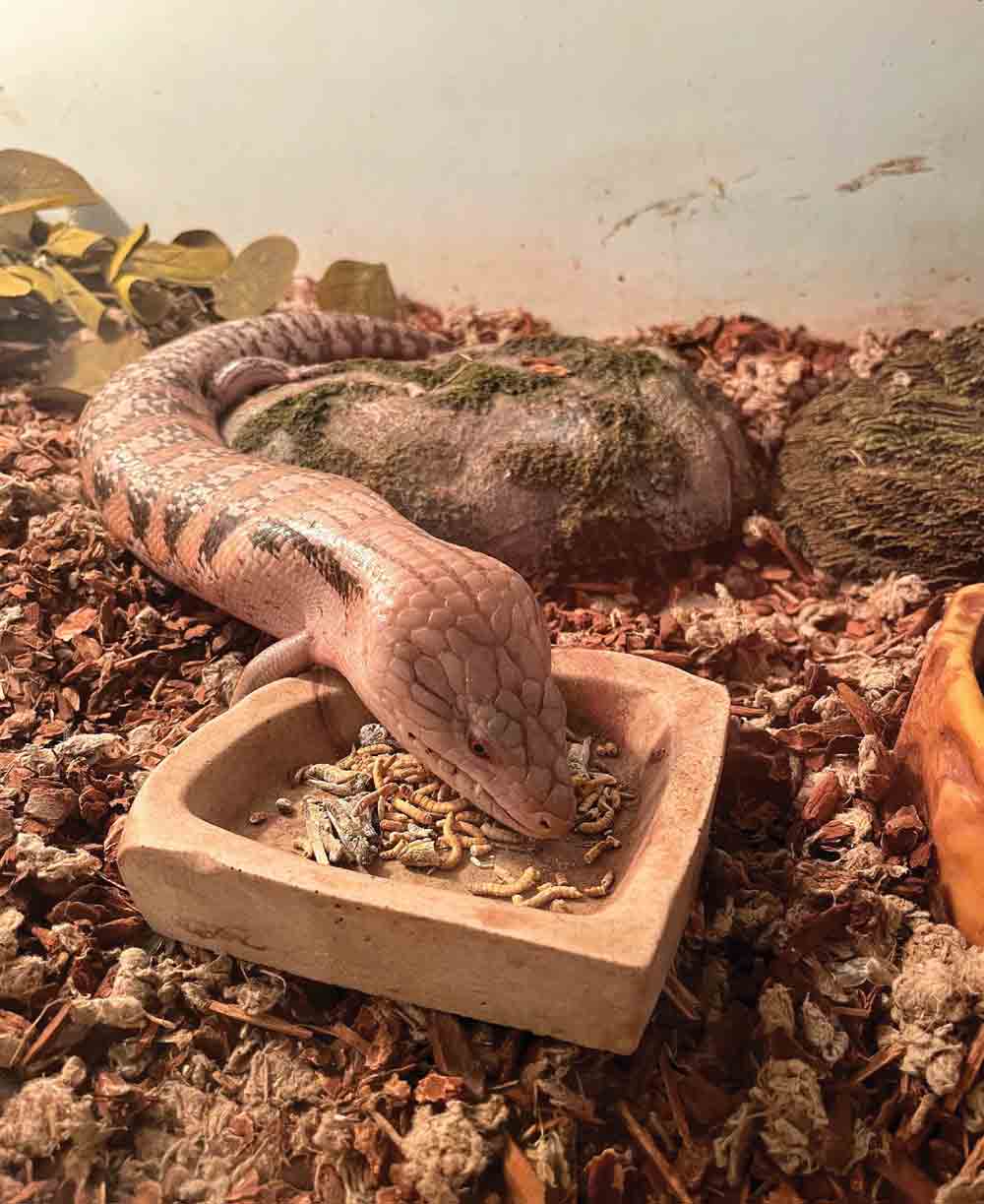
The author adopted Yoshi and had to experiment with different foods before he found what he liked. Photo by Gabby Bunko
Next, you have to answer these questions honestly: Are you willing to care for an animal that may not be completely healthy? Do you have the time and money to help the herp get back to its healthy self? What if an illness leaves permanent damage like metabolic bone disease? Because of the lack of calcium and/or UVB, metabolic bone disease causes reptiles to have jaw and other bone problems that are often permanent. Are you okay with giving the herp the extra care it needs for chronic issues?
If the answers to those health questions are yes, then you have to consider whether you have enough room to house the herp. If you’re like me, you likely already have multiple herps, so it’s important to know what the housing requirements are, and if you have room for them, especially if they already come with housing. The same goes with food. I usually already buy the food a new herp would need, but I always double check to see if pre-owned herps have dietary requirements that I don’t already have or buy. Sometimes previous owners raise picky eaters. Be sure to see if the extra food will work with your budget, especially if the herp is on the larger side, or is very picky with its diet. When I adopted Yoshi, my blue-tongued skink, I had to buy different food because of his preferences from my other lizards, including Odie, my bearded dragon. I adopted both from previous owners, so these questions were at the front of my mind when I decided to adopt them.
If you have the room and food, great! Then you can think about how you would transport the herp from their previous owner’s place to yours. If you have herps already, you’re probably familiar with transporting them back and forth from the vet. If not, most pet stores have pet carriers in the reptile section that are suitable for most herp transport. Make sure to put something on the bottom of the carrier, like a towel, so the herp can feel comfortable and get a good grip. If the herp requires a high moisture level, you can use a mister or spray bottle to make the towel damp, but not wet. If the trip back to your house is longer than an hour or two, make sure to stop occasionally and offer water and food. Have all of this ready before you go over to look at the herp, so you can make the transition as comfortable as possible if you decide to bring the animal home.
Ask Questions
But, before you decide whether to bring the herp home, there are questions you have to ask the current owner. Some of those answers can be found on the listing or ad, but the rest should be in your response to the listing, such as: How old is the animal? Where did they get him? What do they feed him? How much? How often? Does she have a good appetite? Is housing included and, if so, is it appropriate housing with appropriate decor? Would you have to supply the housing yourself, and is that a dealbreaker for you?
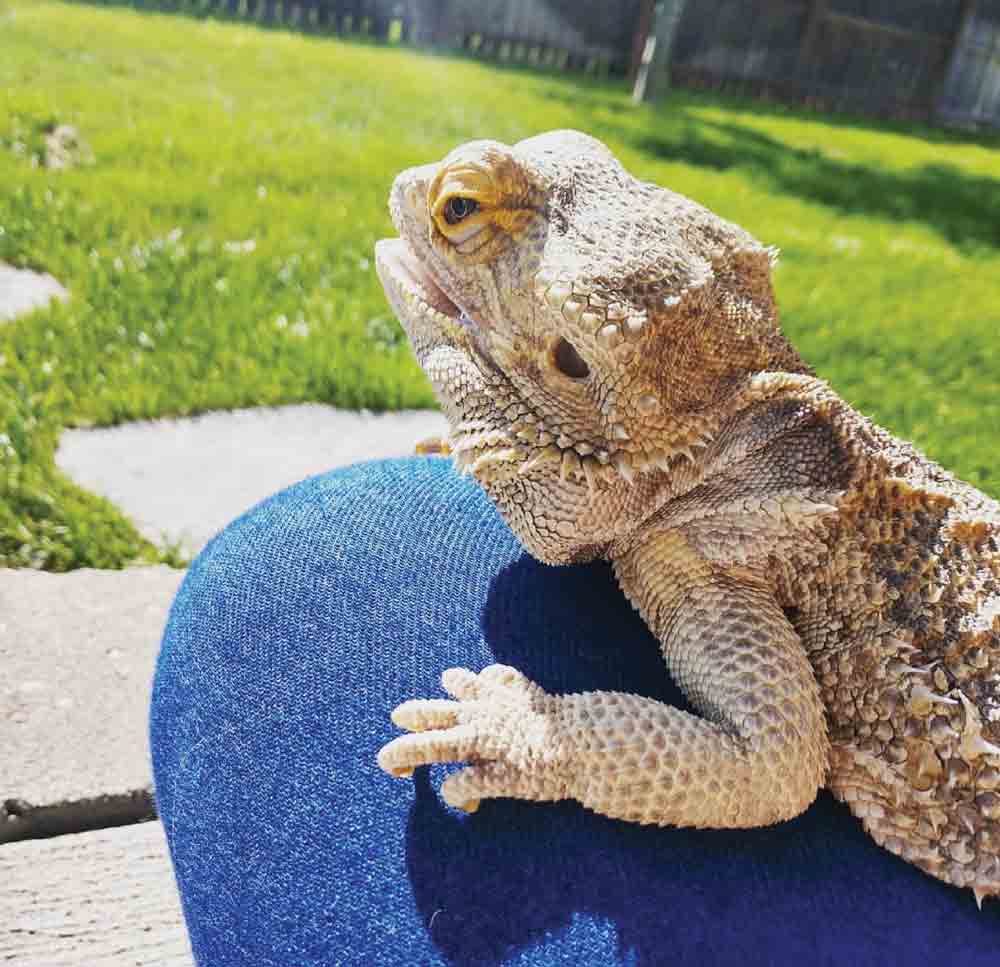
Odie getting some natural UVB. Odie was only ever fed mealworms. The author varied his diet and he became healthy. Photo by Gabby Bunko
If there are no pictures on the listing, you should be a little skeptical, and ask for pictures of the animal before agreeing to see it in person. If they don’t or refuse to send pictures, it might be a scam. Especially on sites that aren’t dedicated to herps, like Craigslist, beware of scams. If the price/fee seems too good to be true, especially along with other red flags, the listing is probably a scam. Never send money or pay ahead of seeing the animal.
Other questions to ask include: What is the herp’s temperament? How often do they handle the animal? Does the current owner have any other pets that have or do pose a danger to the herp? Does the current owner have children, and do they handle the animal and have been taught to do so safely? Has the pet ever had any injuries or illnesses that affect them now? When was their last shed and brumation, if applicable? If everything looks good, then send a reply including these questions so you can gauge whether the herp is still a pet you want to adopt. If yes, then arrange to see the animal in person.
Seeing The Animal In Person
Before you leave to see the animal in person, make sure your transportation arrangements for the herp are ready and in the car. Have money with you to pay in case you choose to buy or adopt the herp if there is a rehoming fee. Most importantly, make sure someone you trust knows where you’re going. If you’re comfortable, have someone go with you, both for safety, and a second pair of eyes to look at the herp.
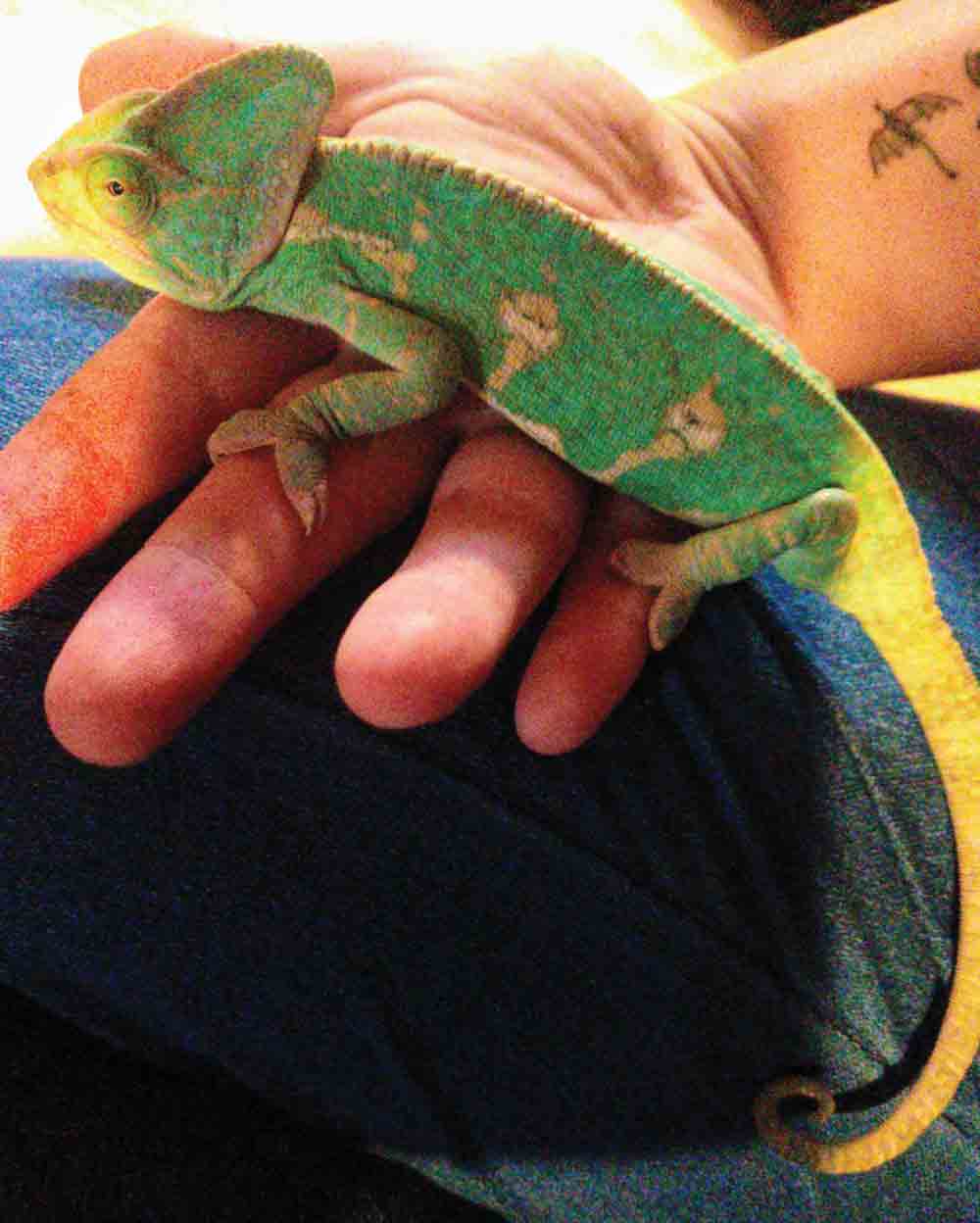
Dino Dan sadly passed away from MBD soon after the author adopted him. Photo by Gabby Bunko
Once there, you can get a good idea of how the herp is cared for when you meet the current owner. If they seem responsible, it’s a good indication that the herp is well cared for. This is not always the case, but it’s usually a green flag. When approaching the animal’s habitat, make sure that it is clean and appropriate for the species. Look for any signs of pests, such as mites, that might spread and affect any other herps you already have. Sometimes the habitat is too small for the animal, even if it’s clean and well kept. With Coco, my leopard gecko, she was housed in a 10-gallon enclosure, which was too small. Everything else looked great, but she didn’t have a lot of room. I knew I had an extra 20-gallon enclosure, so I was okay with taking her home. Check the lighting to make sure they are getting the appropriate amount of heat and sunlight. If they have high moisture requirements, make sure the habitat is at the correct moisture level, and that it can maintain that moisture level. Thermometers and hygrometers in the tank are good signs.
Next, look at the herp itself. Does its eyes, nose, ears, and mouth look clear? Does it seem to be at a healthy weight? Is its skin or scales clear and free of cuts or burns? If it has scars, ask the owner what happened and what they did to help. Make sure there are no mite bite marks or signs. If everything looks good, ask to see the animal eat. A healthy animal will have a good appetite, but also keep in mind that certain species are nocturnal and only eat at night, or don’t eat that much. Don’t be too worried if it doesn’t eat in those cases. But be sure to know your species to decide whether the herp not eating presents a problem.
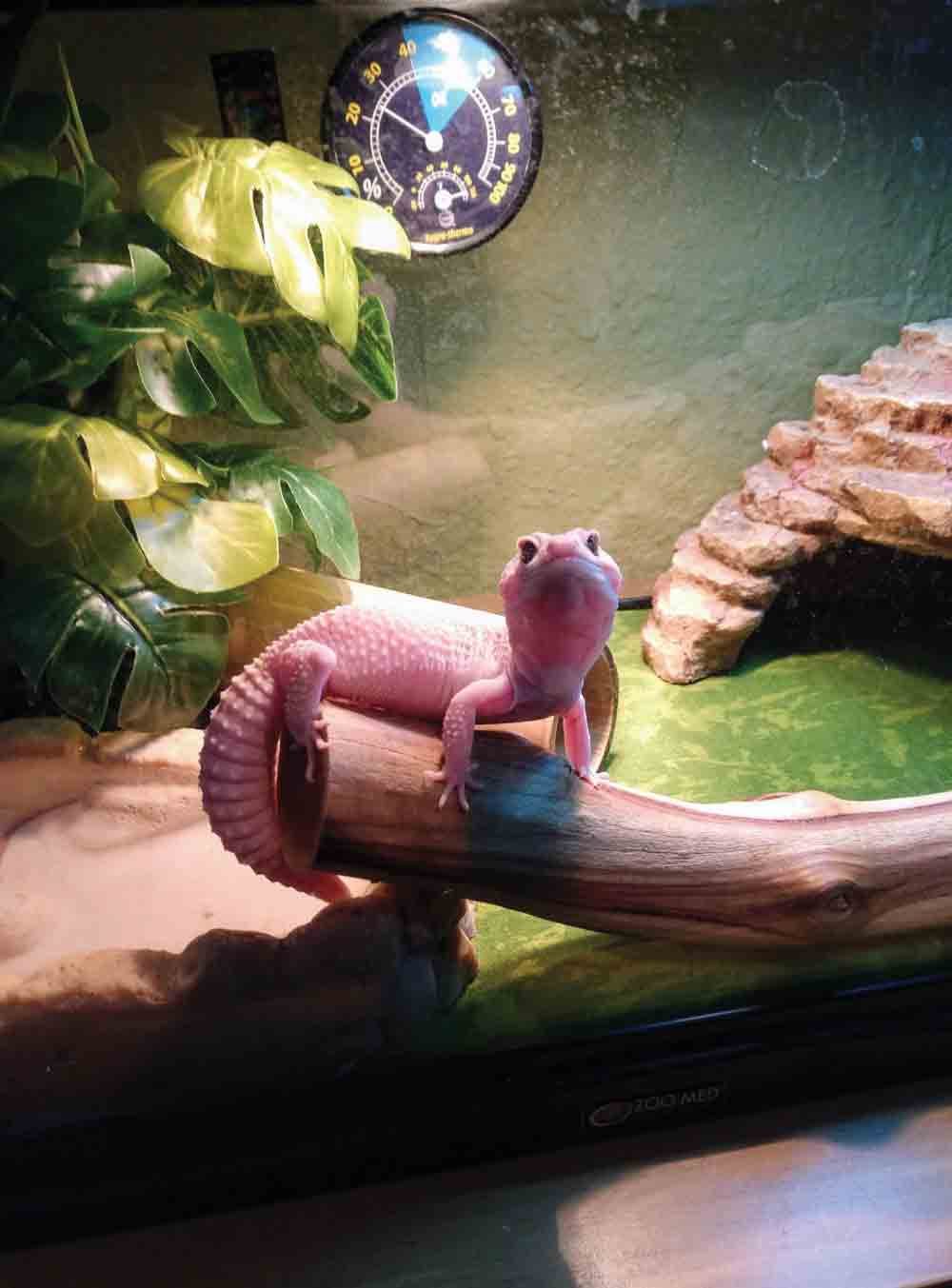
Coco was never handled by her owner, who was 12 years old. Coco has since warmed up to the author. Photo by Gabby Bunko
Also, consider what they eat. Odie, for example, was only ever fed mealworms. Bearded dragons should have a more balanced and diverse diet than just mealworms, as they are very fatty, but Odie refused to eat anything other than mealworms for the first few months. He was close to two pounds when I adopted him. It took a lot of coaxing to vary his diet, but he eventually got used to eating crickets and some safe fruits and vegetables, which brought him down to a healthier weight.
Feeding should also help you get insight into the herp’s temperament. Is it relaxed around you and its owner? Is it afraid when presented with food or when you walk up to the enclosure? If the species is able to be handled, is it acclimated to being picked up and held? Temperament isn’t necessarily completely connected to its owner, but owners do have influence over how the animal reacts to being handled and fed.
When I went to see my leopard gecko, Coco, she was very active and ready to eat. She wasn’t afraid of people and was happy to come up to me when I stepped closer to take a look at her eyes. However, I learned from her previous owner, who was about 12 years old, that her mom would not allow her to hold Coco because she was afraid of salmonella. While I understood, that also meant Coco was not used to handling at all. We’ve gotten to trust each other a bit more now, so I can pick her up when I need to clean her cage, but she is not happy about it.
Blue-Tongued Skink Care and Information
While there are opportunities to build trust, like with Coco, there is the possibility that the herp might not ever become comfortable with handling. Sometimes that’s just their personality, and sometimes their previous owners never got them used to it when they were young. If you want to be able to handle the herp you wish to adopt, it’s a serious consideration when they aren’t used to being handled.
If the temperament of the herp and everything else looks good, and you feel comfortable, add the herp to your family. Always ask the previous owner if they have any tips or special advice for the animal. That may save you a headache later, especially with feeding as you will know what they will and will not eat.
You Got the Herp Set Up In Its New Home! What Next?
Once you have your new friend situated in its new home with you, the next steps are to make sure it’s eating and drinking regularly. Set up a checkup with an exotic veterinarian to make sure the herp is healthy as it adjusts to its new surroundings. Moving is stressful for everyone, and herps are no exception. Certain species, such as chameleons, are more nervous and easily stressed than others. Make sure you see an exotic vet, as they are trained to treat herps.
A vet checkup is also important to make sure there are no underlying conditions that you didn’t catch. Sometimes it’s hard to tell if there’s an underlying condition if there are no physical or behavioral symptoms. Underlying conditions are always a gamble when buying a herp anywhere, but more so when adopting one that has been cared for by someone you don’t know. That unfortunately happened to me when I adopted Dino Dan the veiled chameleon.
A mother had bought Dino Dan for her son, and everything seemed fine with him. They only had him for three months and he looked very healthy, ate quite a few crickets, and had a pretty decent habitat set up. I’d always wanted a chameleon and had done my research ahead of time to make sure I could care for him properly. After setting up his habitat, I went to change the bulbs in the heat lamps because I prefer to make sure they have the correct lighting. Instead of basking and UVB bulbs, they used regular light bulbs like you would find in your house. I immediately called the vet to see if I could move his appointment up. Dino Dan hadn’t had actual heat or sunlight for three months, and I knew that chameleons are easily subject to metabolic bone disease. He ended up having it, and the disease progressed rapidly. By the time of the vet appointment, he could barely walk or use his mouth. The treatments weren’t enough, and he sadly passed away not long after.
This story is not meant to be discouraging, but to show you that you should check the bulbs before taking a new pet home, and that sometimes, despite your best efforts, herps with a previous keeper can have problems you can’t solve. The best you can do is give them a good home and quality of life while you can. That’s why it’s important to consider the questions at the beginning of this article when choosing whether to adopt a pre-owned herp.
In Conclusion
I myself have had more successes than failures. Odie lived to be 11 years old, and nine of those years were with me. Coco and Yoshi are still happy and healthy, and we’ll get to grow old together. One of the three Mississippi mud turtles I adopted from a previous owner, Arya, just passed away from old age. For me, adopting herps with previous owners has given me many family members that have made my life better. But it’s not for everyone, so be careful and honest with yourself about whether adopting a pre-owned herp is right for you.
If it is, and all goes well, you get to enjoy a new friend and family member and give a home to a herp that needs one!
Gabby Bunko has been caring for herps since the age of 5 and has been adopting and caring for them from previous owners for more than 10 years.

